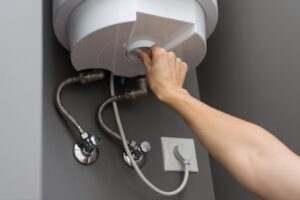Water Heater – to Flush or Not to Flush?
A water heater is a home appliance that helps to heat water for use in showers, sinks, and washing machines. There are two main types of water heaters: storage water heaters and tankless water heaters. Storage water heaters have a tank of water that is heated and then stored until it is needed, while tankless water heaters heat water on demand. Water heaters are an essential part of many homes, and choosing the right water heater can save you money and improve your home’s water supply. So, if your home’s water heater is not performing as well as it used to, you may be wondering, should I flush my hot water heater?
Yes, you should periodically flush your hot water heater when it is not performing well. As this will help to remove any sediment that has built up over time, which could be causing your unit to work less efficiently. Also, flushing helps to prevent corrosion and can prolong the life of your water heater. However, you should avoid flushing it too often, as it could damage the water heater.
If you have never flushed your water heater before, or if it has been a while, you may want to have a professional do it for you. This will ensure that the job is done properly and that your unit is not damaged in the process. However, if you do choose to flush your water heater, be sure to follow the manufacturer’s instructions carefully to avoid damaging the unit. You may be able to flush your water heater yourself, but if you’re not comfortable doing so, you can hire a plumber to do it for you.
Causes of Water Heater Issues
If your water heater is not performing as well as it used to, there are several potential causes other than a build-up of sediment. These include:
- A broken heating element
- A faulty thermostat
- A blocked or restricted water supply line
- A damaged or corroded tank
If you are unsure of the cause of the problem, it is always best to consult a qualified professional for help. Trying to fix the problem yourself could make matters worse and potentially lead to serious injury.
How to Flush Hot Water Heater
If your water heater is not working as efficiently as it used to, or if you notice that the water coming from it is not as hot as it should be, it may be time to flush the unit. Flushing the water heater will remove any sediment that has built up over time and will help to restore its efficiency.
Flushing a water heater is a relatively simple process that only takes a few minutes, but it does require some special equipment. If you decide to do it yourself, be sure to follow the manufacturer’s instructions carefully. If you have a gas water heater, you’ll need to turn off the gas before flushing it. Be sure to read the manufacturer’s instructions carefully before doing this. Once the gas is shut off, open the cold water valve and allow the tank to empty.
Here is a step-by-step guide to flushing your water heater:
1. Turn off the power to the unit.
If your water heater is electric, flip the switch that controls it to the “Off” position. If it is gas-powered, turn the knob to the “Pilot” setting.
2. Turn off the water supply to the unit.
There should be a shut-off valve somewhere on the incoming water line; turn this to the “Off” position. Disconnect the water supply line from the tank and connect a garden hose to the drain valve. Open the drain valve and allow the water to run out until it’s clear. Close the valve and reconnect the water supply line.
3. Connect a garden hose to the drain valve at the bottom of the water heater.
If there is no drain valve, you can open the pressure relief valve to allow water to drain out. Turn on the cold water valve and let the tank fill up completely. Once it’s full, turn on the hot water tap and let the water run until it’s hot. Turn off the tap and let the water sit in the tank for a few hours so that any sediment can settle to the bottom.
4. Open the drain valve or pressure relief valve and allow the water to drain out until it runs clear.
This may take several minutes.
5. Close the drain valve or pressure relief valve.
6. Turn on the water supply to the unit and allow it to fill up.
After a few hours, turn on the hot water tap and let the water run until it’s clear. Turn off the tap and open the drain valve to empty the tank again. Close the valve and repeat this process a few more times until the water coming out of the tap is clear.
7. Turn on the power to the unit.
If it is electric, flip the switch to the “On” position. If it is gas-powered, turn the knob to the “On” position. Once the water is clear, turn on the gas and relight the pilot light. Allow the water to heat up and then turn off the gas again. Open the cold water valve and let the tank refill completely. Close the valve and your water heater should be flushed and ready to use.
8. Allow the unit to heat the water before using it.
Flushing your water heater regularly will help to keep it running efficiently for many years to come.

How to Avoid Flushing Water Heater
While it is good to flush your water heater every once in a while, you should not do so too often. So some wonder if there are ways or things to do to take care of your hot water heater without flushing it. There are a few things you can do to avoid flushing your water heater.
One is to check the anode rod and see if it needs to be replaced. If it does, then follow the manufacturer’s instructions on how to do so.
Another thing you can do is to insulate the pipes leading to and from the water heater. This will help keep the heat in and prevent the water from cooling off too quickly.
Finally, you can install a timer on the water heater so that it only comes on when you need it. This will help save energy and keep your water heater from running all the time.
If you follow these tips, then you should be able to avoid flushing your water heater. If you do have to flush it, then be sure to follow the manufacturer’s instructions carefully so that you don’t damage the unit.
Use Caution
If you have a water heater at home, it’s important to be careful when flushing it. This is because water heaters build up sediment over time, and if this sediment is not removed properly, it can lead to problems with your water heater. This is due to several parts of your water heater that can be affected by flushing.
The most important part is the dip tube. This is the tube that delivers the cold water to the bottom of the tank. If sediment builds up on the dip tube, it can restrict water flow and lead to premature wear and tear on the unit.
Other parts that can be affected by flushing include the anode rod, the heating elements, and the thermostat. Sediment can build up on these parts and cause them to work less efficiently. Flushing your water heater will help remove this sediment and keep these parts working properly.
Pros and Cons
There are a few pros to flushing your water heater. First, it can help extend the life of your water heater by removing sediment that can cause corrosion. Second, it can improve the efficiency of your water heater by removing any build-up that might be restricting water flow. Finally, it can also help eliminate any strange smells that might be coming from your water heater.
On the other hand, there are also a few cons to flushing your water heater. First, it’s important to note that you should only flush your water heater if it’s safe to do so. If you have an electric water heater, for example, you’ll want to make sure that there’s no risk of electrocution before proceeding. Second, flushing your water heater can be a bit of a messy process and it could leak. So, you’ll want to make sure that you’re prepared for that and if you have a leak you should call your insurance agent. Finally, you may need to call in a professional to help you with the flushing process if you’re not comfortable doing it yourself.

Conclusion
In conclusion, flushing your water heater is a simple process that only takes a few minutes and it is a crucial part of maintaining it. As it can help extend the life of your unit and keep it working properly for years to come. Ultimately, the decision is up to you. So, if you feel comfortable doing it and you think that it will benefit your water heater in the long run, then go ahead and flush it out. However, it’s important to follow the manufacturer’s instructions carefully to avoid damaging the unit. As well as calling a professional to take a look or do the job if you’re not sure whether or not it’s necessary or if you’re not comfortable doing it yourself.

